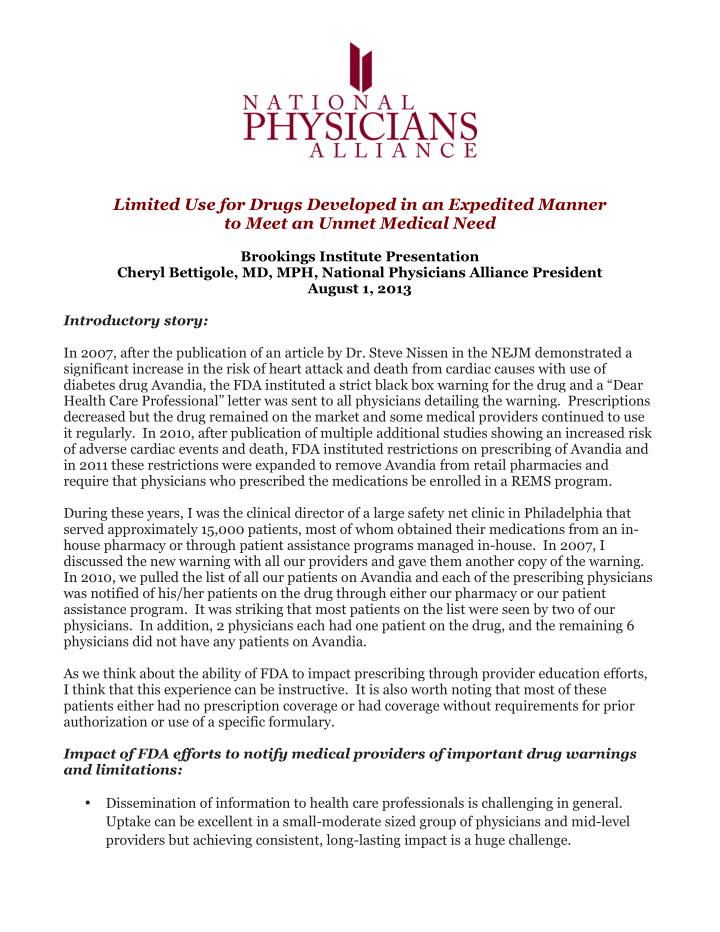



Limited Use for Drugs Developed in an Expedited Manner to Meet an Unmet Medical Need Brookings Institute Presentation Cheryl Bettigole, MD, MPH, National Physicians Alliance President August 1, 2013 Introductory story: In 2007, after the publication of an article by Dr. Steve Nissen in the NEJM demonstrated a significant increase in the risk of heart attack and death from cardiac causes with use of diabetes drug Avandia, the FDA instituted a strict black box warning for the drug and a “Dear Health Care Professional” letter was sent to all physicians detailing the warning. Prescriptions decreased but the drug remained on the market and some medical providers continued to use it regularly. In 2010, after publication of multiple additional studies showing an increased risk of adverse cardiac events and death, FDA instituted restrictions on prescribing of Avandia and in 2011 these restrictions were expanded to remove Avandia from retail pharmacies and require that physicians who prescribed the medications be enrolled in a REMS program. During these years, I was the clinical director of a large safety net clinic in Philadelphia that served approximately 15,000 patients, most of whom obtained their medications from an in- house pharmacy or through patient assistance programs managed in-house. In 2007, I discussed the new warning with all our providers and gave them another copy of the warning. In 2010, we pulled the list of all our patients on Avandia and each of the prescribing physicians was notified of his/her patients on the drug through either our pharmacy or our patient assistance program. It was striking that most patients on the list were seen by two of our physicians. In addition, 2 physicians each had one patient on the drug, and the remaining 6 physicians did not have any patients on Avandia. As we think about the ability of FDA to impact prescribing through provider education efforts, I think that this experience can be instructive. It is also worth noting that most of these patients either had no prescription coverage or had coverage without requirements for prior authorization or use of a specific formulary. Impact of FDA efforts to notify medical providers of important drug warnings and limitations: • Dissemination of information to health care professionals is challenging in general. Uptake can be excellent in a small-moderate sized group of physicians and mid-level providers but achieving consistent, long-lasting impact is a huge challenge.
• Healthcare providers understand FDA approval as a mark of drug safety and effectiveness. Providers have little knowledge about the nuances of FDA processes. • Pharmaceutical representatives continue to be a major source of information about new drugs and new uses for currently available drugs for many health care providers. These representatives have little incentive to stress warnings and precautions for the products they promote. One recent study in which physicians were surveyed immediately after speaking with pharmaceutical representatives showed that only 6% of interactions included a discussion of drug risks and that the majority of black-box warnings were not discussed. Off-label promotion including promotion of drugs approved only for special populations should be expected to expand after the recent federal Court of Appeals decision essentially allowing off-label promotion as a form of free speech. • An FDA study published in 2001 in JAMA of the impact of repeated “Dear Healthcare Professional” letters and labeling changes on liver function monitoring for patients on triglitazone (Rezulin) demonstrated “no meaningful or sustained improvement in liver enzyme testing” and concluded that “Evaluation of the impact of regulatory actions is needed before such actions can be regarded as effective or sufficient.” • This is very consistent with my experience as a medical director. There is essentially a bell curve of medical providers and some will adhere closely to FDA recommendations, but getting the meaningful adherence needed for the special populations approach while limiting prescribing in other populations with educational efforts alone would be near impossible. • Labeling of prescriptions: prescribers do not see drug labels as FDA’s own studies show. Patients need a very high literacy level to read and understand most FDA warnings. Thus relying on labels to help convey that medications are only approved for use in special populations is unlikely to have broad impact, and will put vulnerable populations with lower literacy rates at particularly high risk. A few stats on health literacy in the US: o Approximately 90 million people in the US have limited health literacy o 20% of US population reads at 5 th grade level or below o According to the Center for Health Care Strategies, a disproportionate number of minorities and immigrants are estimated to have literacy problems: 50% of Hispanics 40% of Blacks 33% of Asians More than 66% of US adults age 60 and over have either inadequate or marginal literacy skills Conclusions: 1) Approval of medications for special populations is likely to result in physician prescriptions for much broader populations based on current data. 2) Efforts to educate prescribers using “Dear Healthcare Professional” letters and drug labeling are unlikely to have a significant and widespread impact on prescribing. 3) Due to health literacy issues, we can anticipate that efforts to educate patients through labeling will have limited efficacy, particularly for vulnerable populations.
4) Many patients do not have prescription coverage or have coverage that does not include payer limits on which medications may be filled. As a result, it is unlikely that payer controls will be effective at keeping prescriptions only to special populations.
Recommend
More recommend